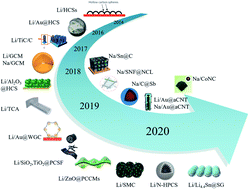Recent advances in carbon-shell-based nanostructures for advanced Li/Na metal batteries
Abstract
Lithium/sodium metal anodes (MAs) have been investigated for the next-generation high-energy density batteries due to their high theoretical capacity and low redox voltage. However, the high reactivity and infinite volume expansion of the lithium/sodium metal induce dendrite growth and formation of an unstable solid electrolyte interface (SEI), leading to serious side reactions, low coulombic efficiency (CE), electrode degradation and even severe safety problems, dragging the lithium/sodium MA out of practical applications. Numerous strategies are explored to construct stable SEI layers and inhibit the dendrite issue. Carbon shell structures have attracted increasing attention, and they have been developed to host the Li/Na metal due to electrochemical stability, high ionic and electrical conductivity, lightweight, easy modification, high Young's module and reinforced stable SEI films. In this review, according to the main function of the carbon shell, it is divided into three categories: carbon shell as the protective layer, nucleation layer and the scaffold of the three-dimensional (3D) host. We summarize the recent advances of various carbon shells in terms of functions, structures, merits and challenges in the application for lithium/sodium MAs. It is expected that carbon shell structures can provide great opportunities for high-energy density lithium/sodium metal batteries.



 Please wait while we load your content...
Please wait while we load your content...